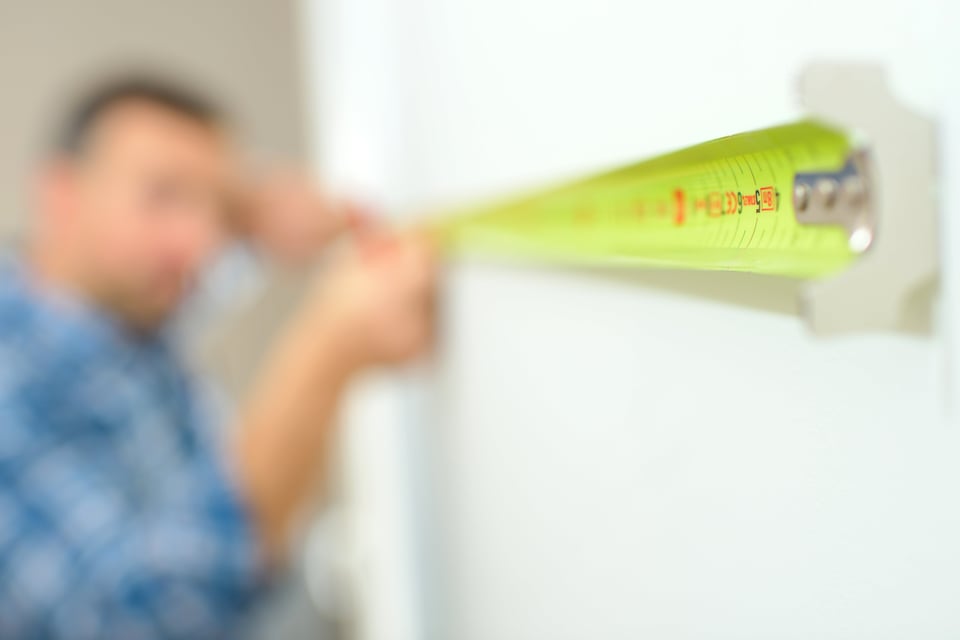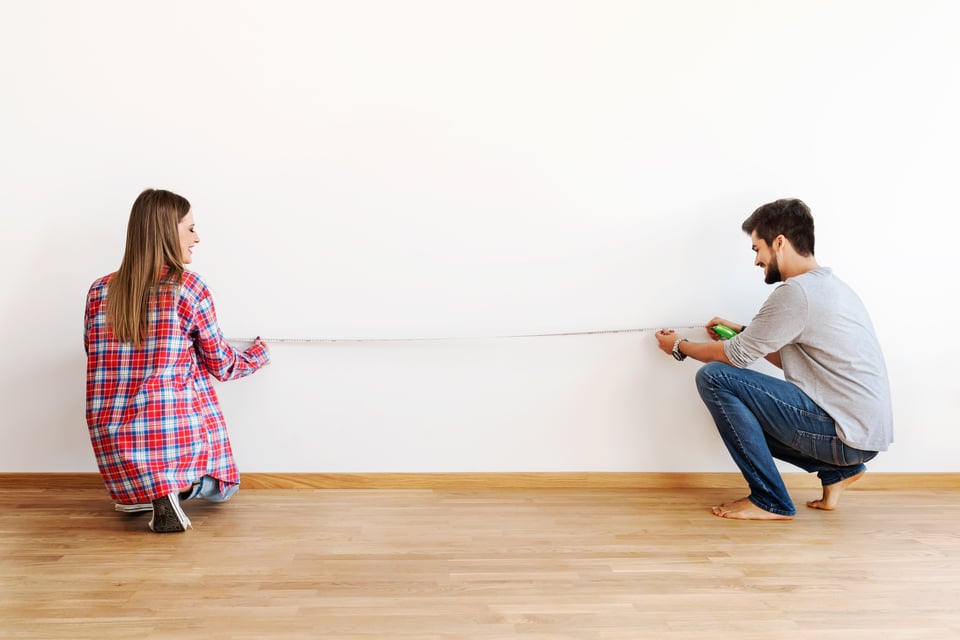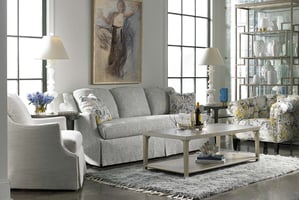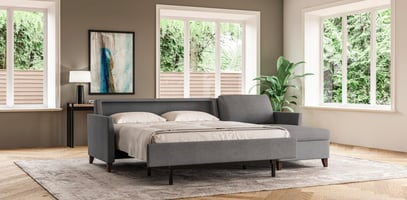Sherrill Furniture is a long-standing company, with quite the reputation as one of the leaders in...
Measuring My Living Room to Make Sure My Furniture Will Fit

As you’ve been looking around for new furniture, you’ve probably noticed that a lot goes into your final decision. Of course, you want your furniture to look a certain way, there’s a comfort factor for sure, and now you’re worried if everything you want will actually fit in your space.
It’s a legitimate concern and an important thing to think about. Because really, even the highest quality furniture that looks amazing can quickly ruin the overall aesthetic of your living room if it just doesn’t fit right.
At McElheran’s Furniture + Design, we’ve seen our customers get into this predicament before. They find that perfect piece of furniture – it checks all the boxes for them – but they’re quickly met with the worry of: “Oh no, what if this isn’t going to fit?!”
And, perhaps you’ve learned the hard way that ‘eyeballing’ your measurements… well, that doesn’t always work out. When you’re looking to invest in something, like furniture, it’s best to have the confidence that you can fit everything in your space.
On top of that, fit is so much more than just getting something through a doorway. Even if you can squeeze a sofa into your living room, it still might feel too big and overwhelm the space, leaving little room for anything else.
That’s where measurements come in! By taking the time to accurately measure a few things in your living room, you can ensure your furniture will fit and work within the space.
Our in-house designers, Design Guides, understand the importance of getting the right measurements from you, and which ones are more vital to your overall plan. In this article, the Design Guides will share:
- Why taking measurements are important
- What you’ll need to accurately measure your space
- What you should be measuring
We’ve got some bonus tips for you, too, to really make sure you’ll get the look you want, and everything will fit into your living room!
Why is measuring my living room important
- You can determine scale so that the furniture and accessories are well-proportioned to each other and the rest of the room.
- You can make sure the furniture can actually get into the space.
- It will help to determine the appropriate amount of spacing required between items in the room to allow for traffic flow.
- You will avoid costly mistakes by not buying ill-fitting pieces.
What will I need to get an accurate measurement of my living room?
Tape measurer
There are ways to measure without a tape measurer, for sure. You can do the old heel-to-toe-walk-around-the-room thing, but that’s pretty time-consuming and leaves a lot of room for error and inaccuracies.
A helping hand
 PHOTO CREDIT: lordn/Adobe Stock
PHOTO CREDIT: lordn/Adobe Stock
Honestly, having a second (or third) person around will just make things easier! They can hold one end of the tape measure or take notes on the different measurements.
Something to record the measurements
Have you ever measured something thinking you’d remember it and then minutes later, POOF! It’s completely gone from your memory!? Especially when you’re taking multiple measurements, it’s great to record it somewhere, so you can always refer to the information.
What should I measure in my living room before buying furniture?
Length and width
These are pretty basic measurements, but they’re important! If you’re only going to measure one thing in your living room, make it the perimeter. This will give you the overall size of the room and a great place to start when looking for furniture that will fit.
The height
This is more of a concern if you have particularly low ceilings or you’re looking to get tall furniture into your space, like a bookshelf. This measurement may be helpful to know, too, in the event furniture needs to be stood up vertically as it’s maneuvered into a space.
The size of the windows
Knowing the size of your windows (length and width) is helpful, and a key thing to also measure is the height of the window off the floor. If the window is high enough off the floor, you can still use that wall as backing for furniture.
If your windows are larger, however, and go all the way down to the floor, that certainly takes away some wall space and should be noted when you’re figuring out furnishings.
Permanent fixtures and built-ins
Fireplaces and built-in shelving take up space in your room and they’re likely not going anywhere! You should definitely take their measurements so your new furniture can co-exist with these fixtures.
Existing pieces that you’re keeping in the space
Are there pieces that you or a designer would have to consider or workaround? It would help to know the measurements of those, so the vacant space can be filled accordingly.
If you have an area rug that you’re keeping, measure that. Rugs are often used to anchor a seating area and can give you a starting point to build out the rest of your look.
And while we’re talking about measurements here, this is how you can determine a good size for living room area rug.
Points of entry into the living room
These measurements are good to know for two main reasons:
- You know if you can get your furniture into the space.
- Ensure that the furniture won’t block these entryways
The route the furniture will take when brought into the space
It’s one thing getting furniture into your living room, but can you get it through the front door or up a narrow stairwell? See what path your furniture will take on the way to your living room and make sure you measure out the doorways, hallways, or any other obstructions that you’ll have to work around.
Any fixtures that determine the start of an adjacent room
Sometimes with an open concept plan, it can be hard to determine the exact dimensions of a room. So, where should you measure to if you don't really know the where one room ends and another begins?
For example, if your living room is right next to your kitchen, it would be helpful to measure to the edge of the island, should you have one. This will help you or a designer figure out the appropriate amount of space that is needed between rooms for traffic or seating, if the island has stools.
Bonus tips for measuring your living room for new furniture
- Start in one corner: Then, work your whole way around until you’re back to that corner. That way you know you’re covering all of your bases.
- Measure twice: What is that saying in carpentry? Measure twice, cut once. Yah, the same goes for furnishing a space. If you double-check your work, you’re way less likely to make an expensive mistake!
- You can’t over measure: Honestly, you don’t have to go crazy with your measurements and get the exact dimensions of every nook and cranny. However, at McElheran’s, we have NEVER had a customer come in disappointed that they measured too much. But we have seen people frustrated for not measuring enough, that’s for sure!
What else can I do to make sure my new furniture will fit?
One of our Design Guides, Kirsti, encourages you to draw out a quick sketch of the room. It doesn’t have to be perfect - or even to scale - but if you can show a rough idea of the shape of your room, where the entry points are, and any fixed elements, you’re well on your way to coming up with a plan.
I need help with measuring my space
Say no more! Honestly, that’s really part of most design services. Check out How to Prepare for an In-Home Design Consultation. You’ll see that the Design Guides can do the measuring at your appointment.
But if you’re comfortable with getting out the measuring tape on your own, that’s great! We’d love to take your measurements and help you plan out your space from there. Drop by McElheran's so you can start picking the (appropriately sized) furniture for your living room!

-min-1.png?width=800&name=DesignButton(png)-min-1.png)


